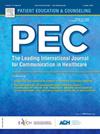The difficult inpatient, prevalence and characteristics
IF 2.9
2区 医学
Q2 PUBLIC, ENVIRONMENTAL & OCCUPATIONAL HEALTH
引用次数: 0
Abstract
Background
Up to 18 % of ambulatory clinic patients are considered difficult by their primary care providers. Two qualitative studies suggest that inpatient medicine providers also commonly experience hospitalized patients as difficult. There have been no quantitative studies of how often hospitalized patients on medicine services are perceived as difficult. Our study purpose was to assess the prevalence and characteristics of difficulty.
Methods
Hospitalized patients were randomly selected and their inpatient providers (hospitalist, non-hospitalist medicine faculty, medicine resident and interns) completed surveys on experiencing patients as difficult. Difficulty was rated on a dichotomous (yes/no) and continuous (0−10) scale. Characteristics extracted from the chart included patient demographics, cognitive status, Charlson comorbidity index, length of stay, and whether the patient had a chart diagnosis of depression, anxiety, PTSD, chronic pain, somatization disorders or personality disorders.
Results
There were 322 surveys completed on 202 unique inpatients; 24.5 % were considered difficult. Age, mental health comorbidities (depression, anxiety), and medical complexity were not associated with being perceived as difficult. On multivariate analysis, personality disorders (OR: 5.4, 95 % CI: 2.6–10.9) and chronic pain (OR: 2.1, 95 % CI: 1.2–3.8) were the only characteristics independently associated with increased difficulty ratings.
Limitations
Single site, VA patients, potential response bias.
Conclusion
Medicine inpatients are commonly experienced as difficult by their providers. Chronic pain and personality disorders increased the likelihood of being experienced as difficult.
住院困难、患病率及特点
背景高达18% %的门诊病人被他们的初级保健提供者认为困难。两项定性研究表明,住院医疗服务提供者也普遍认为住院患者难以相处。目前还没有关于住院病人接受医疗服务被认为困难的频率的定量研究。我们的研究目的是评估困难的患病率和特征。方法随机抽取住院患者,由住院医师、非住院医师、住院医师和实习医师对患者的困难感受进行问卷调查。难度评分采用二分法(是/否)和连续法(0 - 10)。从图表中提取的特征包括患者人口统计学、认知状况、Charlson合并症指数、住院时间,以及患者是否有抑郁、焦虑、创伤后应激障碍、慢性疼痛、躯体化障碍或人格障碍的图表诊断。结果202例特殊住院患者共完成问卷调查322项;24.5% %认为困难。年龄、心理健康合并症(抑郁、焦虑)和医疗复杂性与被认为困难无关。在多变量分析中,人格障碍(OR: 5.4, 95 % CI: 2.6-10.9)和慢性疼痛(OR: 2.1, 95 % CI: 1.2-3.8)是唯一与难度评分增加独立相关的特征。局限性:单位点,VA患者,潜在的反应偏倚。结论内科住院患者被服务提供者普遍认为难以相处。慢性疼痛和人格障碍增加了被认为困难的可能性。
本文章由计算机程序翻译,如有差异,请以英文原文为准。
求助全文
约1分钟内获得全文
求助全文
来源期刊

Patient Education and Counseling
医学-公共卫生、环境卫生与职业卫生
CiteScore
5.60
自引率
11.40%
发文量
384
审稿时长
46 days
期刊介绍:
Patient Education and Counseling is an interdisciplinary, international journal for patient education and health promotion researchers, managers and clinicians. The journal seeks to explore and elucidate the educational, counseling and communication models in health care. Its aim is to provide a forum for fundamental as well as applied research, and to promote the study of organizational issues involved with the delivery of patient education, counseling, health promotion services and training models in improving communication between providers and patients.
 求助内容:
求助内容: 应助结果提醒方式:
应助结果提醒方式:


